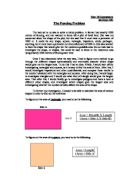The three anions we tested on day one were: fluoride, chloride, and bromide. It took several tries to get some of the spectra to show up correctly. On day two, our lab
Quinn 2
consisted of making two solutions. Each lab had varying concentrations of each of the three anions tested during the first day. The first solution consisted of: 1 ppm chloride, 2 ppm fluoride, and 5 ppm bromide. The second solution was: ½ ppm chloride, 4 ppm fluoride, and 10 ppm bromide.
Results
The first solution ran was the bicarbonate buffer. This buffer showed peaks as following:
The first run of F-:
The first peak, with a retention time of 3.80 minutes, is the F-. Peak #3 at 5.60 minutes is a Cl- contaminant.
The second run of F-:
Quinn 3
The page wasn’t fully copied, so I didn’t have the numbers to the last two peaks. Once again, the peak at 3.77 is the F-. Peaks 4, 7, and 8 correspond to the buffer. The peak at 5.60 is also more Cl- contaminant.
Chloride:
The peak with the greatest area, peak #5, is from the chloride ion.
Bromide:
The peak at 8.70 minutes is the bromide ion peak.
Buffer Day Two:
Quinn 4
Soln. #1:
The peaks in this solution showed up where we expected them. The 2 ppm F- peak was at 3.81 compared to the retention times of 3.77 and 3.80 of the two previous runs at 1 ppm. The 1 ppm Cl- peak showed up at 5.64, the 1 ppm Cl- peak before was at 5.58. Lastly, the 5 ppm Br- had a retention time of 9.01 minutes compared to 8.70 for the 1 ppm solution.
Soln. #2:
The 4 ppm F- peak was at 3.66 minutes this time. The ½ ppm Cl- ion showed up at 5.47 minutes. The 10 ppm Br- appeared at 8.76 minutes, compared to 8.70 minutes for the 1 ppm solution and 9.01 minutes for the 5 ppm solution.
Discussion
Overall, the lab ran smoothly. All of the data suggests that even when you vary the concentrations, the ion elutes out of the column at relatively the same time. Let’s take
Quinn 5
bromide as an example. When the concentration was 1 ppm, the ion eluted at 8.70 minutes. By using 5 ppm sodium bromide, the retention time was at 9.01 minutes. In the last solution, the bromide concentration was 10 ppm, and the retention time was 8.76 minutes. The retention times were all very similar, even though the concentrations were varied.
To sum it all up, I think the column performance was pretty good. The only slight problem we had was that some of the printouts had quite a few extra peaks. I’m not exactly sure what caused these. Also, on both of the sodium fluoride runs, there were obvious chloride peaks from contamination. We made sure to use separate pipets for each solution, so I’m not sure where that came from.







